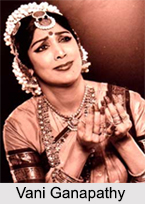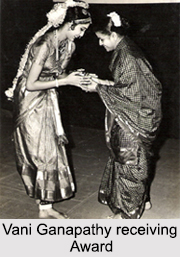 Vani Ganapathy is an Indian Bharatnatyam dancer and also a well-reputed interior designer. She started learning dance at the age of 4 years and went on to establish herself as a foremost exponent of this dance form. She has played an integral part in its rise to international recognition. She has performed Bharatnatyam for many important dignitaries from India and abroad. Vani Ganapathy resides in Bengaluru and runs a dance institution under the name "Sanchari" where she trains various dedicated youngsters.
Vani Ganapathy is an Indian Bharatnatyam dancer and also a well-reputed interior designer. She started learning dance at the age of 4 years and went on to establish herself as a foremost exponent of this dance form. She has played an integral part in its rise to international recognition. She has performed Bharatnatyam for many important dignitaries from India and abroad. Vani Ganapathy resides in Bengaluru and runs a dance institution under the name "Sanchari" where she trains various dedicated youngsters.
Early Life of Vani Ganapathy
Vani Ganapathy was born in Kolkata to parents Ganapathy K. V. and Indubala Ganapathy. Her mother was a renowned vocalist for dance. Vani Ganapathy began her journey with classical dance at the age of 4 years. It was her mother who indoctrinated her to the dance form Bharatnatyam, a classical dance form that originated in the Indian state of Tamil Nadu. In her journey as a dancer, she received complete support from her mother.
Career of Vani Ganapathy
Vani Ganapathy started her training under Guru T. A. Rajalakshmi and in 3 years she performed her “arangetramâ€. It was her first public performance at the age of 7. Since then the art form took a special place in her life. Later, her parents shifted to Mumbai, so she too had to shift her training under nattuvanars of the same bani (tradition) Gurus Mahalingam Pillai, Govindaraja Pillai and Kalyanasundaram. At this time she was accompanied by her sister Meera. The choreography of their gurus was further enhanced by the voice of their mother and they were asked to perform at Raj Bhavan in Mumbai for Indian and foreign dignitaries.
Vani Ganapathy has travelled across the world for her performances. Her stint as a solo dancer began only in 1986 and she gave solo performances in various parts of the world. She performed in places like Australia, Singapore, Malaysia, China, Japan, Nepal, Berlin, Stockholm, London, Geneva, Turin, Middle East and many countries.
During mid 70s, Vani Ganapathy had the opportunity of presenting a programme on Indian television for Doordarshan. The serial focused on the four main classical idioms of dance called “The Rich Heritage†under the young world programme. The serial marked Doordarshan"s entry at the Blue Danube Festival in Europe and was later telecasted by B.B.C. In 1994, she founded "Sanchari", her own dance school.
 Personal Life of Vani Ganapathy
Personal Life of Vani Ganapathy
Vani Ganapathy tied the knot with actor Kamal Haasan in 1978. However, the couple got divorced 10 years later.
Achievements of Vani Ganapathy
For her illustrious career and contribution to Indian art and culture, Ganapathy received awards like:
Sur Singar Samsad
Excellence Award from the then Chief Minister M.G.Ramachandran
Aryabhatta - Natya Shantala
Karnataka Excellence Award
Mantram Achievement Award



















